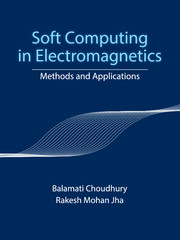Book contents
- Frontmatter
- Dedication
- Contents
- List of Figures
- List of Tables
- Preface
- Acknowledgments
- Abbreviations
- Symbols
- 1 Introduction
- 2 Soft Computing Techniques
- 3 Soft Computing in Electromagnetics: A Review
- 4 Bacterial Foraging Optimization For Metamaterial Antennas
- 5 PSO for Radar Absorbers
- 6 Characterization of Planar Transmission Lines Using ANN
- 7 Fault Detection in Antenna Arrays
- 8 Multi-Objective Particle Swarm Optimization for Active Terahertz Devices
- 9 Soft Computing based CAD Packages for EM Applications
- Author Index
- Subject Index
- References
3 - Soft Computing in Electromagnetics: A Review
Published online by Cambridge University Press: 05 July 2016
- Frontmatter
- Dedication
- Contents
- List of Figures
- List of Tables
- Preface
- Acknowledgments
- Abbreviations
- Symbols
- 1 Introduction
- 2 Soft Computing Techniques
- 3 Soft Computing in Electromagnetics: A Review
- 4 Bacterial Foraging Optimization For Metamaterial Antennas
- 5 PSO for Radar Absorbers
- 6 Characterization of Planar Transmission Lines Using ANN
- 7 Fault Detection in Antenna Arrays
- 8 Multi-Objective Particle Swarm Optimization for Active Terahertz Devices
- 9 Soft Computing based CAD Packages for EM Applications
- Author Index
- Subject Index
- References
Summary
Soft computing finds application in a wide range of problems in both engineering and nonengineering fields. Chapter 1 of this book discusses the potential applications of soft computing in fields ranging from engineering to finance, and architecture among others, etc. As the focus of this book is on design optimization of electromagnetic applications, it is necessary to understand the common optimization problems, and the advances and solutions to overcome them. Hence, a comprehensive review of soft computing techniques with a focus on electromagnetic applications is reported in this chapter.
Overview
An important aspect of electromagnetic applications is design and optimization towards actual hardware realization. In this chapter, an extensive literature survey of the soft computing techniques for electromagnetic applications has been carried out. It is observed that artificial neural network (ANN) and genetic algorithm (GA) has been employed extensively for diverse microwave engineering applications [Choudhury et al., 2012]. In contrast, emerging soft computing techniques like particle swarm optimization (PSO) and bacterial foraging optimization (BFO) have not been explored comprehensively for these applications. Hence, soft computing techniques for various microwave engineering applications such as antenna engineering, frequency selective surfaces, radar absorber design applications, microwave devices, etc., are systematically reviewed in this chapter. This chapter also identifies the emerging trends and suitability of different soft computing techniques for various electromagnetic design and optimization problems.
Radar Absorbers
As the name suggests, electromagnetic absorbers are devices that absorb any incident radiation. In other words, the reflection off, and transmission through these devices is zero and the entire incident energy is absorbed by the materials present in the absorbers. The resonant properties of these absorbers are dependent on the constituent material, structure, and morphology. Conventionally, most absorbers are multi-layer in nature and consist of multiple dielectrics stacked one above the other. The thicknesses of these layers play an important role in the performance of the absorber. In addition, advances in the field of metamaterials have resulted in the use of metamaterials in absorber designs. A multi-band metamaterial absorber is given in Fig. 3.1 along with the absorption characteristic. It is seen that each peak in the absorption characteristic corresponds to a ring in the metamaterial structure [Shen et al., 2011]. Therefore, it is clear that designing of radar absorbers is a complicated task and requires careful manipulation of material and structural properties.
- Type
- Chapter
- Information
- Soft Computing in ElectromagneticsMethods and Applications, pp. 45 - 64Publisher: Cambridge University PressPrint publication year: 2016



